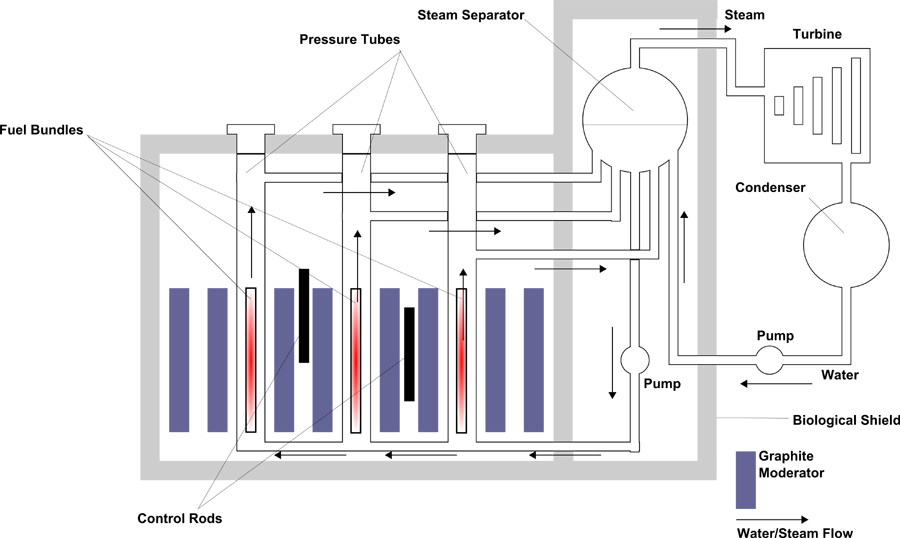
Home Page Previous Page Next Page
RBMK's Concept
The core of an RBMK reactor is made of graphite blocks, it is the moderator which slows down the neutrons produced by the fission of uranium. This is obviously a huge structure, big as a house.
This mass of graphite is pierced with 1661 vertical holes in which are inserted the pressure tubes of about 3.5 inches (9 centimeters) in diameter, containing uranium and leading the cooling water under a pressure of 1000 psi (70 kg/cm²) from the bottom toward the top of the reactor. This water is intended to cool down the pressure tubes and the graphite and provide steam to drive turbines.
In each pressure tube, uranium is contained in 18 rods about 0.5 inch (13 millimeters) in diameter. The height of the core is 21 feet (6.5 meters).
The structure of graphite is locked in a steel tank about 42 feet (13 meters) in diameter. A mixture of helium and nitrogen is injected to enhance the quality of the caloric transfer between the graphite and the pressure tubes and perhaps also to reduce the oxidation of graphite.
On the outside, around the core has been constructed a building, intended only to prevent radioactive leaks. This concrete building contains screens of sand and water to absorb radiation. In operation, the graphite temperature reaches about 700 °C (1,300 °F) in the reactor. At this temperature graphite is glowing red and does not ignite because an inert gas (helium/nitrogen) is sent continuously. But if the air (thus the oxygen) was entering the enclosure, the graphite will ignite.

Block diagram of a RBMK reactor
(There are two similar sets in a reactor)
The core of the reactor is covered with a concrete slab weighing about 1,000 tons. Under the lower part of the slab are attached the upper ends of all the pressure tubes.
In an RBMK reactor, there are two separate pressure loops feeding each a turbine installed in a building next to the reactor. In Chernobyl NPP, each of RBMK 1000 reactors produces an energy of 925 MW.
The RBMK reactors did not have a surrounding wall for full containment. The pipes beneath the reactor were placed in what the Soviets called the anti-leak boxes. These boxes were connected to a vast pool beneath the entire building. That pool was used to trap the steam and the radioactive particles if a pressure tube or a pipe was broken. But the higher piping was only protected by an standard industrial building. If a pipe breaks on the higher part, this would result in a leak of radioactive steam whose importance would depend on the speed at which systems emergency will stop the reactor.
The accident at Three Mile Island's nuclear power plant in 1979, confirmed to the world that a complete confinement was necessary for the safety of a nuclear power plant. The first RBMK reactors, including those in the Leningrad power plant, had not even a partial confinement.
But the RBMK is enormous, the building is very large, about 71 meters high, and achieve a complete confinement as on the U.S. reactors would cost a lot. Thus, the Soviets preferred to have confidence in their security systems for their power plants, rather than investing in passive safety of a quality confinement.
Apparently, in the Soviet system, human lives are cheaper than the material. No matter, as the essential principle of communism is to never make mistakes!
The combination of a graphite moderator and a water cooling does not exist in any other reactor. This design makes the reactor unstable at low power, and this is confirmed by the Chernobyl accident. This instability was due mainly to the design of the control rods and the positive void coefficient.
A positive void coefficient has the consequence of increasing the power of the reactor. If the quantity of steam increases in the cooling water, the bubbles generated in boiling water decrease the coefficient of moderation of the water. And a spiral begins, the water boils, the reactor increases its power, so water boils more and so on.
The RBMK reactors have a high positive void coefficient because they work with low-enriched uranium and use light-water instead of heavy-water.